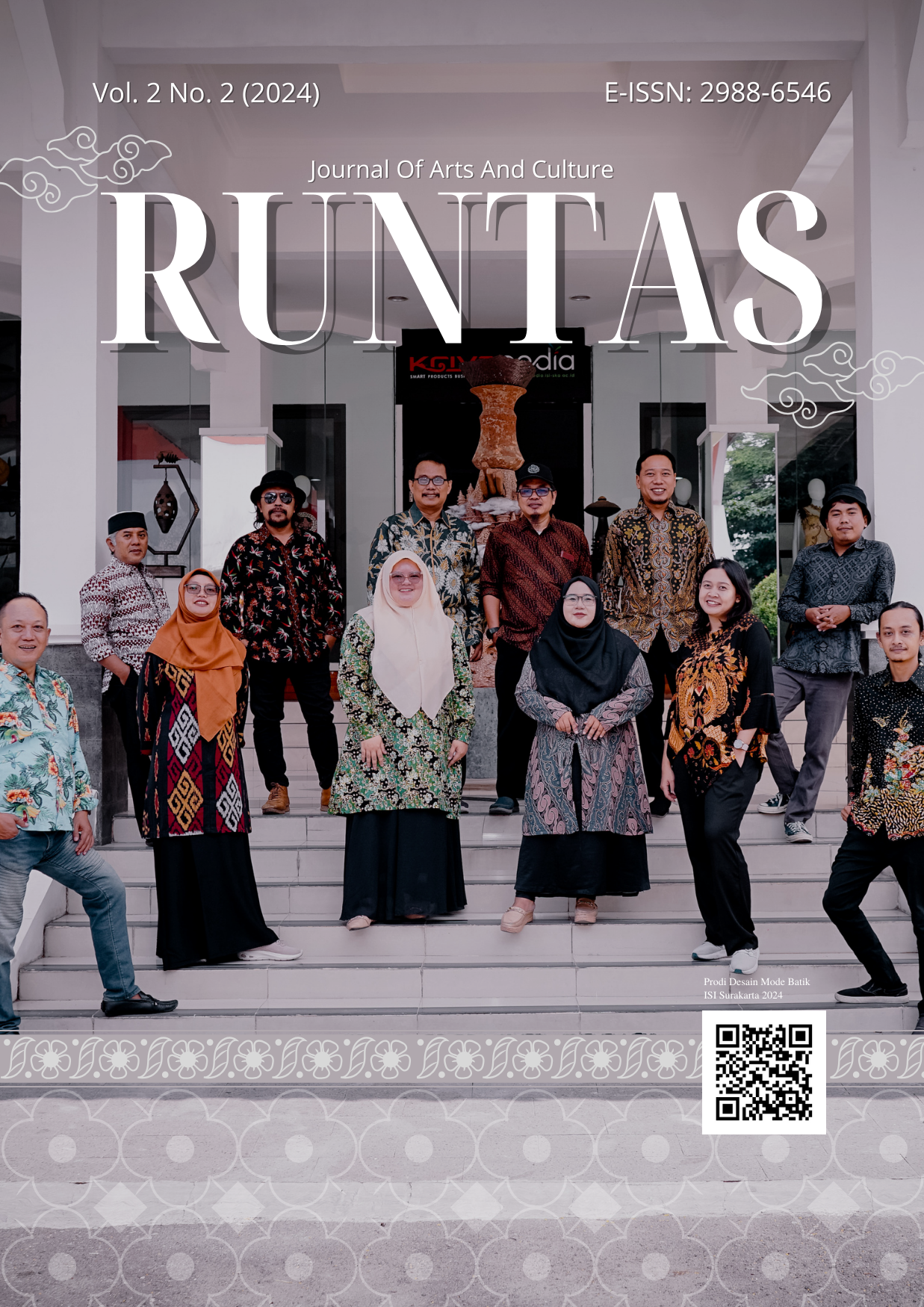AN EFFORT TO PRESERVE NATIONAL CULTURE BY CREATING BATIK MOTIFS ON WOMEN'S CASUAL CLOTHING WITH THE THEME OF LARUNG SESAJI
DOI:
https://doi.org/10.33153/runtas.v2i2.4844Keywords:
Batik Tulis, Casual Clothes, Larung SesajiAbstract
The work entitled An Effort to Preserve National Culture by Creating Batik Motifs on Women’s Casual Clothing with the Theme of Larung Sesaji was created to satisfy the interest of revealing the meaning behind the celebration of Larung Sesaji. The work is aiming at creating a new batik motif with theme of Larung Sesaji as well as an identification of Indonesian culture applied in women’s casual wear. The creator hopes that this effort can inspire the other creators to contribute to promote Indonesian culture through their works. This creation uses three stages and six steps, namely data collection stages, design stages, and embodiment stages. Data collection stage was conducted through an observation at the ceremony of larung sesaji. The collected data are then be used as a substance for the design stages, namely to design or visualize the source obtained into an alternative, selected, and perfected designs. The embodiment stage or making real works of batik was conducted with the cover dye technique employing natural colors and then sewing it to create casual clothing for women. The work managed to create four fashion creations, entitled Bahtera Sagara by the name of Lakara Meraki motif, Rahsa Linuhung in the name of Abyudaya Dakara motif, Grahita Sampena by the name of Hirap Mara motif, and Dahayu Kalis by the name of Asa Arshaka motif. Each creation is complemented by accessories such as earrings, hair ornaments and shoes. By this work, the creators try to introduce the public, especially young people, the idea of the important of preserving Indonesian culture.
Downloads
References
Musman, A., Arini, A. B., & Kenyar, M. N. (2011). Batik: Warisan adiluhung nusantara.
Jakarta. Yogyakarta : G-Media
Santrock, J. W. (2011). Life-span development (13th Edition). Jakarta : Erlangga
Soekamto, C. I. (1984). Pola batik. Jakarta : Akadoma.
Sunjata, P. Wahyudi. 2012. Upacara Tradisional Jawa. Yogyakarta: Andi Offset.
Gustami, S. P. (2007). Butir-Butir Estetika Timur Ide Dasar Penciptaan Seni Kriya
Indonesia. Prasista :Yogyakarta.
Ernawati, Izwerni, & Nelmira, W. (2008). Tata Busana SMK kelas X. In Direktorat
Pembinaan Sekolah Menengah Kejuruan, Direktorat Jenderal Manajemen
Pendidikan Dasar dan Menengah, Departemen Pendidikan Nasional. Direktorat
Pembinaan Sekolah.: Jakarta.
Cahyana, Agung, FP Sri Wuryani, dan Sumadi. 2017. Optimasi Produksi Batik dengan
Teknik Wax Print Screen (WPS) untuk Perajin Batik Kembang Keli di Kabupaten
Wonosobo. Surakarta: Jurnal Batoboh Vol. 2 No 2, 10: 77-84.
http://dx.doi.org/10.26887/bt.v2i2.351
Evita, L. (2021). Makna Sosial Tradisi Massorong Sesajen Dalam Budaya Masyarakat
Pengkajoang Kabupaten Luwu Utara. Skripsi. Program Studi Pendidikan
Sosiologi. Universitas Muhammadiyah Makassar:Makassar.
Moerniwati, E. D. A. (2013). Studi Batik Tulis (Kasus Di Perusahaan Batik Ismoyo Dukuh
Butuh Desa Gedongan Kecamatan Plupuh Kabupaten Sragen. Skripsi. Program
Studi Pendidikan Seni Rupa. Universitas Sebelas Maret:Surakarta.
Anggraini, E., & Sulistiani, Sri. (2018). Upacara Tradhisi Larung Sesaji ing Desa Serang
Runtas: Journal of Arts and Culture | Vol. 00 No.00 | Page
page
Kecamatan Panggungrejo Kabupaten Blitar (Semiotik Kultural). Baradha, Hal 1-
Guntur, G. (2021). Inovasi Desain Motif Parang: Studi Kasus Koleksi Museum Batik Danar
Hadi. Dinamika Kerajinan Dan Batik, 38(1), 29–44.
https://Doi.org/10.22322/Dkb.V36i1.4149
Purnomo, M. A. J. “Batik Encim Pekalongan, Kehalusan Batik Gaya Cina Di Pesisir
Jawa”, Pendhapa: Journal of Interior Design, Art and Culture, Vol. 1, No. 1.
(2010)
Sudarwanto, A. (2019). Penerapan Model Bentuk Tranformasi Menggunakan Teknik
Karakter Terkuat Untuk Menghasilkan Motif Batik. Texture: Art and Culture
Journal, 2(1), 1–11.
Prihatin, T., & Kusumasari, S. M. (2020). Perancangan Busana Casual Wanita Dari Bahan
Jumputan Dipadu Bahan Lurik. Jurnal Socia Akademia, 6(1), Hal 40.
Soemarjadi, M., & Muzni, Z. Wikdati. 2010. Pendidikan Keterampilan. Departemen
Pendidikan Dan Kebudayaan Direktorat Jenderal Pendidikan Tinggi Proyek
Pembinaan Tenaga Kependidikan.
Putri, Mia Helmi. 2019. Anggrek Sebagai Sumber Ide Penciptaan Motif Batik Untuk
Busana Pengantin,Laporan Tugas Akhir. Program Studi Desin Mode Batik. Institus Seni
Indonesia Surakarta: Surakarta.
Hasanah, M., & Sukarman. (2021). Upacara adat larung sesaji di pantai Kedung Tumpang
kecamatan Pucanglaban Kabupaten Tulungagung. BARADHA : Jurnal Pengembangan
Bahasa, Sastra, dan Budaya Jawa, 18(2), 1–
https://ejournal.unesa.ac.id/index.php/baradha/article/view/38783
Nurhayati, D. A., & Ambari. (2020). Jurnal Pendidikan Kewarganegaraan Undiksha Vol.
No. 2 (Mei, 2020). JUrnal Pendidikan Kewarganegaraan Undika, 8(2), 157–167.
https://doi.org/10.23887/jpku.v8i2
Trisnawati, T. Y. (2016). Fashion sebagai Bentuk Ekspresi Diri dalam Komunikasi. Jurnal
The Messenger, 3(2), 36. https://doi.org/10.26623/themessenger.v3i2.268
Trixie, A. A. (2020). Filosofi Motif Batik Sebagai Identitas Bangsa Indonesia. Folio, 1(1),
–9









